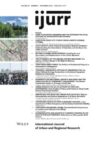Large-scale, state-subsidized housing programmes have experienced a renaissance in Africa, Asia and Latin America, but provoke justified concerns about whether they miss their target groups. Unaffordability, lack of choice, peripheral locations and under-serviced sites are common problems. Ultimately, many subsidized units are not occupied by their intended recipients. Most authors see this as a form of gentrification or downward-raiding, whereby higher income groups displace housing recipients towards poor-quality housing elsewhere. However, most research fails to include the perspectives of those who do not occupy or who vacate their units, mainly because of the methodological challenges of locating these people. Consequently, little information exists about the secondary residential mobility of the ‘missing people’ of state-subsidized housing programmes. Where do they move to, why do they leave? This comparative study of three of the most significant housing programmes in Africa analysed 101 housing pathways of such people in the capital regions of Ethiopia, Morocco and South Africa. Rejecting a unilateral notion of displacement, I suggest a new conceptual perspective that sees people who do not occupy their allotted housing units as active subjects reconfiguring supply-driven, shelter-centric housing policy according to their own needs, while also being affected by (severe) financial constraints.
Details
Written by:
Raffael Beier
Digital Object Identifier (DOI)
https://doi.org/10.1111/1468-2427.13365
About DOI

